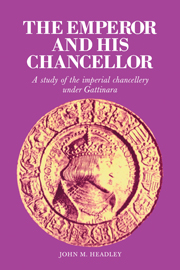Book contents
- Frontmatter
- Contents
- Acknowledgments
- List of abbreviations
- Introduction
- 1 The administrative threshold
- 2 The emerging government of Charles V
- 3 The conflict between chancellor and emperor
- 4 The imperial chancellery
- 5 The imperial propaganda campaign of 1526–1527
- 6 The last years of the chancellorship
- Epilogue
- Appendix 1 The Summary by Philippe Hanneton, audiencier of the Burgundian chancellery, regarding the office of the Grand Chancellor
- Appendix II ‘The Doubts of [Alonso de] Soria’, lieutenant protonotary, concerning Gattinara's proposals for reforming the Aragonese chancellery
- Appendix III Gattinara's ‘Brussels Remonstrance’
- Appendix IV Gattinara's proposals for the more effective operation of the Council of State
- Appendix V A comparative analysis of the movements of the imperial court and the imperial chancellery 1518–1530
- Bibliography
- Index
3 - The conflict between chancellor and emperor
Published online by Cambridge University Press: 07 October 2011
- Frontmatter
- Contents
- Acknowledgments
- List of abbreviations
- Introduction
- 1 The administrative threshold
- 2 The emerging government of Charles V
- 3 The conflict between chancellor and emperor
- 4 The imperial chancellery
- 5 The imperial propaganda campaign of 1526–1527
- 6 The last years of the chancellorship
- Epilogue
- Appendix 1 The Summary by Philippe Hanneton, audiencier of the Burgundian chancellery, regarding the office of the Grand Chancellor
- Appendix II ‘The Doubts of [Alonso de] Soria’, lieutenant protonotary, concerning Gattinara's proposals for reforming the Aragonese chancellery
- Appendix III Gattinara's ‘Brussels Remonstrance’
- Appendix IV Gattinara's proposals for the more effective operation of the Council of State
- Appendix V A comparative analysis of the movements of the imperial court and the imperial chancellery 1518–1530
- Bibliography
- Index
Summary
If during the Calais conference the seeds of future administrative friction and dislocation were sown, the bitter first fruit became evident to Gattinara himself with the return of the emperor to Spain in July 1522. According to a hitherto overlooked memorandum, part consulta, part remonstrance, that Gattinara composed probably in July of 1525, which will be designated here as the Brussels remonstrance, the chancellor dated the beginning of his ordeal from these months subsequent to Charles' reappearance in the peninsula. Although the remonstrance attributes to the gout a protracted illness in the late autumn, Salinas speaks of a pain in Gattinara's side accompanied by a severe coughing that kept the chancellor incapacitated for forty days. In fact it was feared that he would die and even though his recovery relieved the minds of many at court, Salinas observed that such an illness for a man of his age did not augur well. Wracked anew by the gout, forced to try to keep up with the roving court of his master as it moved from Valladolid to Burgos and later to Pamplona and Vitoria, Gattinara sensed his authority as chancellor being circumvented and his influence with the emperor waning. Added to his extreme physical discomfort and his growing fear as to the reduction of his office and role in the Habsburg administration was the increasing anxiety caused by his mounting debts and Charles' failure to pay a salary that was one year in arrears.
- Type
- Chapter
- Information
- The Emperor and His ChancellorA Study of the Imperial Chancellery under Gattinara, pp. 40 - 58Publisher: Cambridge University PressPrint publication year: 1983



